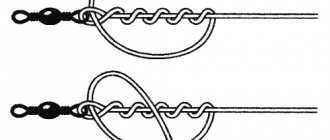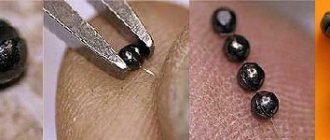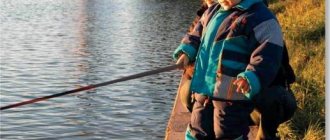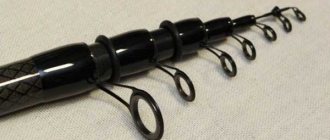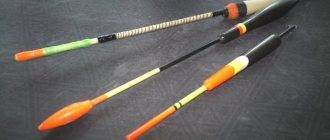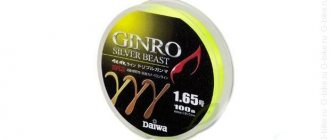Some species of fish look for food on the surface of the water or in its middle layers. From above you can catch perch, bleak, silver carp and chub. To catch other species of fish, mostly peaceful ones, you have to go to the bottom, since they find food for themselves without rising to the surface. Donka with an elastic band is one of the most promising and reliable methods of catching such fish. The rubber shock absorber helps to cast the tackle more accurately, creates less noise from casting and allows you to place several hooks (up to 10 pieces).
What is a rubber shock absorber and where is it used?
Content
Rubber shock absorbers appeared back in the 90s, but then they were made from pharmaceutical rubber bands. They were cut into strips and attached to a fishing line. There were more professional options, but they all quickly broke down. In addition to the need to constantly mount the elastic, the loss of the weight was also a problem.
The main purpose of a rubber shock absorber for fishing is to facilitate casting into the same area, as well as reduce noise levels. It was difficult for other bottom gear to get into the baited area. Rubber shock absorbers allow you to accurately throw the bait to a specific point in the reservoir.
The latest modification of such a donkey is a rubber shock absorber with a safety line attached to the sinker and the main line (in case of a break, it prevents the loss of the sinker), as well as an additional line, which is tied to the buoy. The role of the buoy is to monitor the location of the cargo, and additionally protects against falling into an undesirable place. Now the tackle is quite compact and brings a good catch.
The rubber shock absorber for the fishing rod is intended for catching deep-sea fish in still water; as an alternative, lane fishing is used in fast rivers.
Bottom tackle with a rubber shock absorber is designed for fishing from the shore and differs from other bottom tackles by the presence of a rubber insert between the main line and sinker
When compared with a drop bottom, a rubber shock absorber demonstrates a number of advantages:
- the tackle is suitable for both experienced fishermen and beginners;
- helps to get exactly to the baited place. The most effective bait mixtures: ready-made with the addition of clay, in PVA packages (they dissolve after a short exposure to water), paper;
- The bait can be thrown in with minimal noise. The donka silently sinks into the water, without scaring off peaceful, shy fish species;
- There are many hooks attached to the tackle, sometimes up to 10 pieces. The quantity directly depends on the casting distance and the type of reservoir. Hooks are placed along the entire line to prevent tangling;
- It is convenient to use soft bait mixtures, which often fall off the hook or can be damaged. Live bait, dough, bloodworms and chatterbait are often used.
Read more
What is a running donk and what is it used for?
Donka with a rubber shock absorber also has disadvantages:
- low mobility - it will take a lot of effort to change the fishing location;
- short service life of the rubber band on the fishing rod;
- frequent breaks of the ends of the shock absorber lead to the need to always have spare equipment and spend time collecting it while fishing;
- the angler may be injured when the gear breaks.
When using a fishing rod with a cast, only 1 shock absorber with 5 hooks is installed on the fishing rod per 1 angler.
Tackle idea
But the classic donka has certain disadvantages. The main thing is that throwing the tackle at the same point is quite difficult. That is why an improved tackle was invented that allows you to place the bait on the bottom at the same pre-fed point with an accuracy of a few centimeters.
Initially, one single element was introduced into the classic bottom equipment - a rubber shock absorber. In Soviet times, it was sold in fishing stores. Some fishermen used rubber bands sold in pharmacies to attach shock absorbers.
This element of equipment had one significant drawback - it quickly lost elasticity and frayed. As a result, the tackle did not serve for a long time and broke down. As a result of the breakage of the shock absorber, a lead load remained in the water, which also cost money.
As a result, a safety line was added to the rigging system, which was tied directly to the sinker and made it possible to save the sinker in the event of a break. The gear was a bit bulky, difficult to cast and took up a lot of space on the bank.
The third improvement made the shore gear more compact. An additional safety line was tied at one end to the sinker of the donkey, the other end was tied to a special buoy, which, after casting the tackle, floated to the surface.
He:
- indicated the location of the load for spinning anglers and other miners;
- performed insurance functions.
Advantages of the tackle in comparison with the donka-tank
In comparison with a donka-zakidushka, a donka with a rubber shock absorber has the following advantages:
- A donka with a shock absorber allows you to target feeding to a specific place. For bait, you can use a bait mixture mixed with clay, PVA bags (which dissolve after a while when placed in water), pieces of newspaper (in which the bait is wrapped).
- Groundbait can be presented with minimal noise by attaching it to the hooks, carefully lowering the water and slowly releasing the main line.
- In this fishing method, you can use a larger number of hooks (up to 10 pieces depending on the reservoir and casting distance), which can be spread along the main line so that they do not get tangled.
- The ability to use delicate, soft baits, which, when casting a bait, are torn off the hook or damaged (bloodworms, dough, chatterbox or live bait)
- This type of bait creates much less noise when casting. The cast, accompanied by a loud splash, happens only once. Less noise is less likely to scare away fish.
Main disadvantages
The main disadvantages include:
- Low mobility of this gear. It is difficult for an angler with this type of donkey to change the fishing location;
- Short service life of the rubber shock absorber;
- The tackle often breaks, therefore it requires the presence of spare elements of the equipment.
- A broken rubber shock absorber can cause injury to the angler.
We would like to draw your attention to the fact that there are restrictions on fishing with a hook - you can only use one rubber shock absorber, equipped with 5 hooks, per angler
How to make a donk with a rubber shock absorber?
A donka with a shock-absorbing damper is a simple piece of equipment, it is easy to use and easy to make yourself.

-yourself donk rubber is made from:
- fishing line with a cross section of 0.2 mm or more (can be replaced with braid). It is wound on a prepared reel; moderate tension should be created. Rings for elastic bands and leashes are attached to the main line, or figure-of-eight loops and loops for other parts of the equipment are made. The location should prevent the gear from getting tangled with each other during retrieval to the feeding area. To prevent the hooks from getting caught, cambrics are installed on the fishing line;
- bottom fishing rod with a rubber shock absorber - a rubber strip with a round cross-section (square blanks are allowed) and a diameter of about 3 mm. Round elastic bands for shock absorbers are intended for peaceful fish, square ones for predatory ones. An easy way to obtain it is to buy the required length in the store; it is sold in prepared sizes of 5, 10, 15, 20 m. The length of the shock absorber is selected taking into account the casting distance. Loops are knitted along the edges of the elastic band, and swivels with fasteners are attached to them;
- lead sinker;
- fishing line, a leash is made from it;
- hooks are selected taking into account the expected load. When making a donkey with an elastic band, the choice of hooks is important, but it directly depends on the size of the bait and its color;
- The buoy and weight cord will help determine the casting location; they are made of material that floats above the water level. The main thing is to ensure the visibility of the buoy from afar. The element is used when it is possible to place the load on the craft in advance. A cord with a weight is attached to the foam (it is better to paint it in a bright color). The length of the fishing line depends on the depth of the reservoir;
- reel, 2 pcs., simplifies transportation;
- bite alarm. An object that indicates the presence of vibrations in the fishing line is suitable: bells, bells, electronic options, etc.
Read more
How to catch sterlet on a donk?
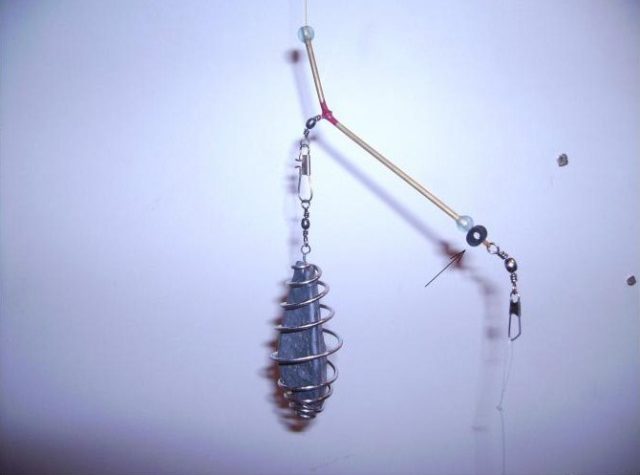
There is a fairly simple relationship: the shorter the shock absorber, the less it will stretch and absorb the jerks of the fish less, that is, it will actually be stiffer
Selecting a shock absorber and installing a connector
The rubber in the rig plays a key role; when biting a large specimen, it is the only thing that separates the fisherman from catching it. You can assemble the tackle with your own hands; to do this, one end of the shock absorber is attached to the connector sleeve, and the other is passed through the rod from the inside and removed from the hole in the whip. The free segment is tied with a loop to the second part, which is installed in its place.
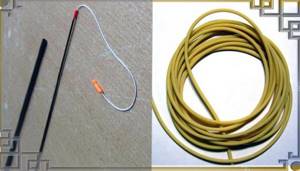
The diameter of the elastic is the main criterion. When catching small fish weighing no more than a kilogram, use a shock absorber up to 1.2 mm thick. Large individuals require an increase in this parameter. The length of the shock absorber directly affects the quality of the development of mining jerks - the shorter the element, the stiffer it is and the less it stretches. That is why you should install longer tires, which will have a reserve reserve when fishing. The thinnest models are built into the first two legs of the rod, and the thickest ones, such as carp ones, are built into three or four segments. Difficult choice of tires causes beginners to make mistakes, so at the initial stage you should consult with more experienced comrades, and also look for information on your own.
To learn more:
Catching predatory fish with a Tyrolean stick
How to tie a fishing line with an elastic band correctly?
The most important condition for quality tackle is good and strong knots. The shock absorber rubber bands are attached using very simple, but durable and strong units. One of the best tying techniques is the clinch. Taking into account the choice of technique for preparing loops for leashes, the method of their installation differs. A simple technique - “loop to loop” - involves creating loops on the main fishing line. On the opposite side of the leash, make a standard loop or figure eight.
You can improve the method by attaching a swivel clasp to the free edge. If the fishing rubber for the donkey breaks or the leash gets damaged, the fisherman will be able to replace the element of the tackle much faster. It will also speed up the disassembly process after fishing is completed.
How to make an elastic band?
The rubber band device is quite simple, but still, difficulties may arise for a beginner. The most important thing is to choose the right length of the rubber itself and throw (carry) the tackle to the optimal distance. You should know that rubber stretches approximately 5-7 times. The ratio is conditional and depends on the specific manufacturer. Before fishing, check how many times your elastic band stretches. Based on this, choose your casting distance. If 10 cm of elastic stretched to 50 cm, placing 5 m of rubber, the load should be sent 25 meters away. Please note that the current also stretches the tackle. In general, with experience, after several fishing trips, understanding comes.
A correctly installed “elastic band” should allow you to take the last hook to the shore without tearing or cutting your hands. On clean sandy ground, this can be adjusted by using thick, durable rubber that can pull the load behind it. Or a cat weight on an additional “cargo” safety cord. In this case, by dragging you can more accurately regulate the tension of the tackle, and more often pull it all out without breaking.

The elastic consists of a main fishing line 0.5-0.6 mm in diameter, and 5 leashes from 20 to 50 cm long, which are attached with special knots at such a distance from each other so as not to intersect with each other. Using the right knots will reduce twisting and tangling. It's great if you use fluorocarbon, it gets less tangled and resists pike teeth better. Doubles selected for the size of the bait are most often used as hooks. For perch - one, for pike teeth both the size of the bait and hooks, of course, will be larger.
Twisters are now common as bait, but at the beginning of the article I described the options that I advise you to alternate: twister-cigarette-cambric-cigarette-twister, I think that this way the fishing efficiency and the number of bites will be increased.
To prevent the tackle from getting tangled when casting, it is better to place the hooks in the water, or use a “dummy” - a fishing line with a carabiner, which is cast with a load, and then the main fishing line with the hooks is hooked. It is convenient to bring elastic on a boat, especially if you are aiming for long distances. In the summer, you can use inflatable mattresses, or even swim, unless of course you are an excellent swimmer.
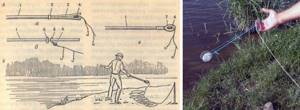
The fact is that the weight for the elastic must be decently weighty so that the tackle is in the same place. It did not pull up when landing fish and was not carried away by the current. Throwing such weight over a long distance is not always possible. Especially if the first coastal edge is at a distance. In this case, you can use a lever - a powerful stick, and the casting distance will increase. If possible, you can make lead grappling weights at home, which will simplify the task. The weight of the load is selected depending on the strength of the current and the power of the rubber. Here you should navigate through experience.
Selection of weights and leashes
During the manufacture of the leash, high-strength versions of thin fishing line (about 0.14–0.2 mm) are used. The length is set at your own discretion, but in standing water it is better to make it 10–20 cm, and in rivers with a current, the length of the leash is 30–40 cm. A hook is attached to the leash at one end, and a swivel is installed at the opposite end, on which a fastener is attached or knitted loop.
Thanks to the weight of the sinker, contact with the bottom of the reservoir is ensured. There are no restrictions on the shape, but many anglers prefer a flat weight, as it does not roll along the bottom in rivers with small currents. If the bottom is covered with a large layer of silt, it is better to use weights in the form of drops or balls. An alternative is to use a bag of stones, but this creates more noise.

Donks with elastic bands use relatively heavy weights
A separate piece of fishing line (about 30 cm) is made for the load, and a fastening loop with a shock absorber is mounted on the edge. The structure of the donkey with an elastic band may differ slightly, but it is impossible to attach the load to the main fishing line in all modifications.
The leader shock absorber will last longer with a lighter weight, so there is no need for too much lead. In any case, it is better to buy elastic for the donk with a reserve; if the tackle breaks during casting, it can be quickly restored.
Fishing technique
Fishing with a donk should not cause any particular difficulties. The fishing process itself differs little from ordinary donkey.
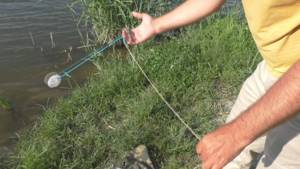
Despite the pre-selected shock absorber, when fishing you often have to adapt to real conditions
Fishing with a donk with a rubber shock absorber is carried out according to the following scheme:
- Installation of the buoy. You need to bring an improvised buoy to an area favored by fish: depressions, holes at the bottom, a quiet bay.
- Feeding the area. All bait is suitable, including soft bait or with a water-soluble coating.
- Throwing tackle. Beginner fishermen ask how to throw a rubber band at the bottom, but in reality there is nothing complicated, the tackle just looks oversized. The most difficult is the first cast, introducing the load. It is important to keep the line tension at the time of casting and remove objects that could interfere with the movement of the line so that the hooks do not get tangled.
- Waiting for a bite. Fishing with a rubber shock absorber comes down to waiting - when a fish bites the hook, the bite alarm will report this.
The best feeder installations
Another advantage of using rubber for the feeder is the increase in sensitivity of the tackle. But sensitivity is not achieved on all equipment. Below will be presented two installations using a feeder shock absorber. Using an asymmetrical loop there will be no increase in sensitivity, but in the second example the sensitivity will increase noticeably.
Using heavy feeders and weights, the bite will be transmitted precisely to the tip of the feeder, and the feeder itself will be motionless. But if the rubber shock absorber is not used, the fish’s effort will be divided into both the feeder and the quivertip, which will make the bite less noticeable to the fisherman.
For a noticeable bite, the fish will have to move the feeder before the angler sees a good pull. And if you fish in a strong current and in great depth, where the water pressure on the line increases, the use of heavy feeders is simply necessary. In such extreme conditions, a feeder shock absorber will be very useful.
